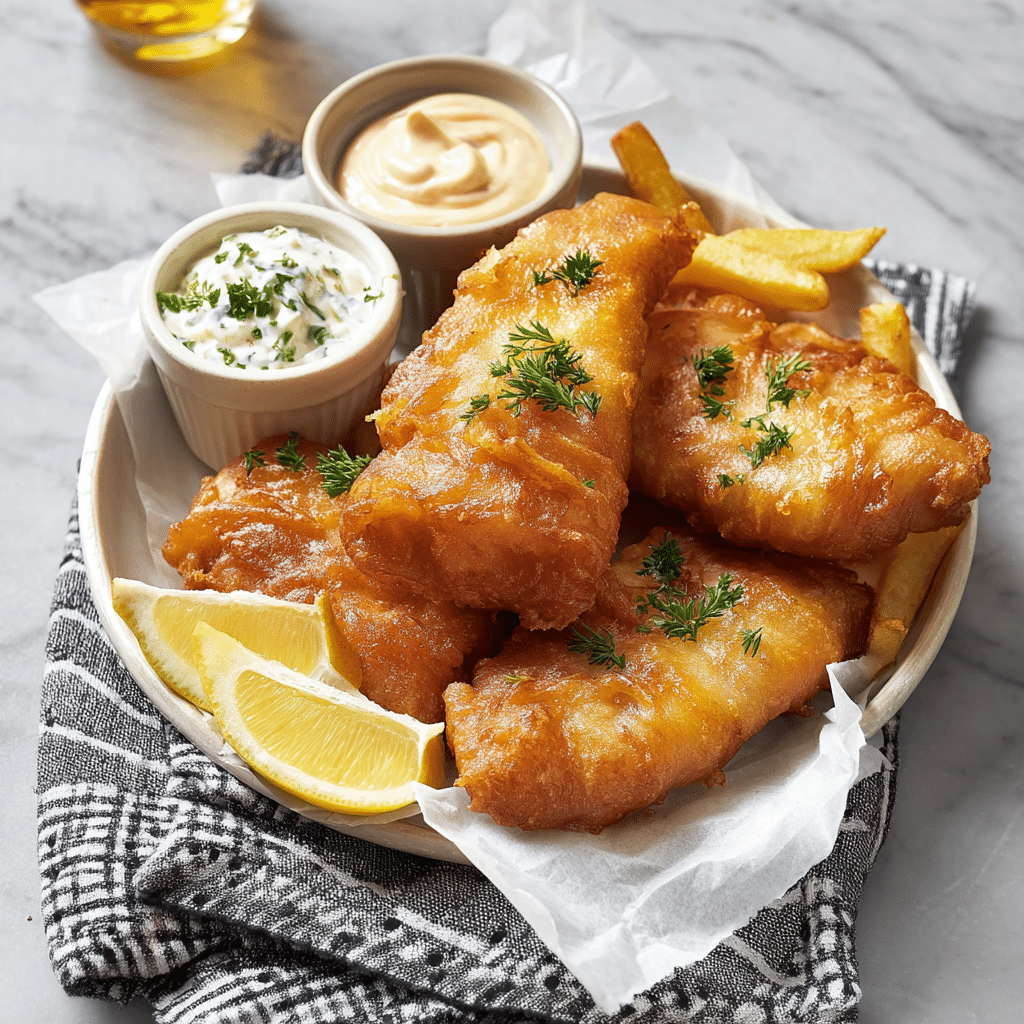The beauty of this Beer-Battered Fish lies in its simplicity and flavor. Tender, flaky cod is coated in a light and airy batter made with beer for that signature pub-style crispiness. A quick deep-fry creates the golden crust that cracks with every bite, while the inside remains moist and delicate.
Perfect for fish and chips night or whenever you’re craving some classic comfort food, this dish pairs well with tartar sauce, lemon wedges, and a pile of hot fries. With just a few pantry staples and minimal prep time, you’ll have a dish that rivals your favorite pub fare—right from your own kitchen.
Full Recipe
Ingredients:
-
1½ lbs cod fillets, cut into 4-6 inch pieces
-
1 cup all-purpose flour, plus ½ cup for dredging
-
1 teaspoon baking powder
-
1 teaspoon kosher salt
-
½ teaspoon garlic powder
-
½ teaspoon paprika
-
1 cup cold beer (lager or pale ale)
-
Vegetable oil, for frying
-
Lemon wedges, for serving
-
Fresh parsley, chopped (optional)
Directions:
-
Heat 2-3 inches of vegetable oil in a deep pan or fryer to 375°F (190°C).
-
In a large bowl, whisk together 1 cup flour, baking powder, salt, garlic powder, and paprika.
-
Slowly pour in the cold beer, whisking until smooth. Let the batter rest for 10 minutes.
-
Pat the cod pieces dry with paper towels. Lightly dredge each piece in the ½ cup of flour, shaking off excess.
-
Dip each floured fish piece into the beer batter, coating completely.
-
Carefully place fish into hot oil, cooking 2-4 pieces at a time depending on size. Fry for 4-5 minutes, or until golden brown and crispy, turning once halfway.
-
Transfer to a paper towel-lined plate or wire rack to drain.
-
Serve hot with lemon wedges and tartar sauce. Garnish with chopped parsley if desired.
Prep Time: 15 minutes | Cooking Time: 20 minutes | Total Time: 35 minutes
Kcal: 390 kcal | Servings: 4 servings
Introduction to Beer-Battered Fish
Beer-battered fish is a timeless comfort food that has made its way from British pubs to home kitchens all over the world. Its appeal lies in the perfect contrast of textures—the crispy, golden brown crust that gives way to tender, flaky white fish inside. Traditionally served with thick-cut fries and a tangy tartar sauce, this dish brings together rich flavor, satisfying crunch, and nostalgic memories of seaside fish and chips. The magic of beer batter lies in the carbonation and slight acidity of the beer, which creates a light, airy coating that crisps beautifully when fried.
This recipe is especially popular with home cooks who want to recreate the classic “fish and chips” experience at home. With minimal ingredients and a relatively quick cooking process, it’s both beginner-friendly and rewarding. From a casual Friday dinner to a weekend family meal, beer-battered fish is a meal that brings people together with its comforting familiarity and irresistible crunch.
The History and Origins of Beer-Battered Fish
Beer-battered fish has strong roots in British culinary tradition, most notably through the beloved “fish and chips” meal. The concept of frying fish in batter originated in England in the 19th century, largely influenced by Jewish immigrants who brought their fried fish recipes from Portugal and Spain. The addition of beer to the batter is a more modern twist that adds depth of flavor and improves texture.
The idea behind beer batter is based on the science of carbonation. When cold beer is combined with flour and other dry ingredients, it releases bubbles that expand in the hot oil, creating a crisp and airy crust. Over time, this beer-enhanced version of battered fish became a pub staple and has since evolved into a favorite in homes around the world.
Why Beer Works So Well in Batter
Beer is more than just a flavoring agent in this dish. The bubbles from the carbonation help aerate the batter, making it lighter and crispier. Additionally, the alcohol in beer evaporates quickly in hot oil, reducing the overall moisture content and ensuring the coating fries up crisp without absorbing too much oil. Depending on the type of beer used, you can also introduce nuanced flavors—pale ales bring mild bitterness, lagers offer clean and subtle maltiness, and darker beers add a richer depth.
For best results, the beer should be cold when added to the batter. This temperature contrast also contributes to the crispy texture during frying. While the alcohol content cooks off during frying, the flavor it imparts lingers subtly, enhancing the dish without overwhelming the delicate fish.
Choosing the Right Fish
Cod is the most commonly used fish in beer-battered recipes, especially for its clean, mild flavor and firm, flaky texture. However, other types of white fish work equally well. Haddock, pollock, halibut, or even tilapia can be substituted based on availability and personal preference.
The key is choosing a fish that is firm enough to hold its shape during frying, but tender enough to flake apart once cooked. It’s also important to pat the fish dry before dredging and dipping it into the batter. Moisture can interfere with the crisping process, leading to a soggy crust rather than a crisp one.
Secrets to a Crispy, Golden Crust
Achieving that perfect golden crunch isn’t just about the batter; technique matters too. First, use a deep-frying method with oil heated to the right temperature—ideally around 375°F (190°C). Too cool and the batter absorbs oil, becoming greasy; too hot and the crust burns before the fish cooks through.
Don’t overcrowd the fryer or pan. Cooking a few pieces at a time ensures the oil temperature stays consistent and the fish cooks evenly. Letting the battered fish rest for a few seconds before placing it in the oil can also help prevent sticking.
After frying, transfer the fish to a wire rack instead of paper towels. This allows air to circulate, preserving the crispiness. Sprinkling a little salt immediately after frying enhances flavor and gives the perfect finishing touch.
Serving Suggestions and Pairings
While beer-battered fish is classically paired with fries (a combination that defines the fish and chips experience), there are many ways to enjoy this dish. Serve it with coleslaw, pickled vegetables, or a fresh green salad for a lighter meal. Tartar sauce is a must-have condiment, but don’t be afraid to experiment with dips like lemon aioli, spicy remoulade, or malt vinegar.
For a complete British pub-style meal, consider adding mushy peas and thick-cut chips. You can even serve the fish in sandwich form, tucked into a crusty roll with lettuce and sauce for a satisfying fish sandwich. And of course, a cold pint of beer makes the perfect beverage pairing.
Making It Healthier (or Easier)
While deep-fried food isn’t typically labeled as “healthy,” there are a few ways to lighten this dish without sacrificing flavor. Use an air fryer for a reduced-oil version, though results may vary depending on batter thickness. You can also opt for whole grain flours or gluten-free flours if dietary needs require.
If you’re short on time or equipment, shallow frying is possible with careful monitoring. While the result won’t be as evenly golden, you can still get a delicious crust with the right oil temperature and attention.
Common Mistakes and How to Avoid Them
One of the biggest pitfalls in making beer-battered fish is having the batter turn out too thick or too runny. A good batter should coat the back of a spoon and cling to the fish without dripping excessively. Letting the batter rest after mixing helps to activate the leavening agents for a fluffier result.
Another common mistake is not drying the fish thoroughly before dredging and battering. Excess water leads to a soggy crust. Additionally, using old or improperly heated oil can result in greasy, limp fish. Always fry in clean oil and monitor the temperature closely.
Overcrowding the pan can also cause temperature drops, so work in small batches. Finally, remember that the fish continues to cook slightly after being removed from the oil, so avoid over-frying.
Cultural Significance and Modern Appeal
Beer-battered fish has grown beyond its British roots to become a global favorite. In the U.S., it’s often featured in seafood platters, fish tacos, or served as a stand-alone dish. In Australia and New Zealand, fish and chips remain a staple coastal food. It’s even become a popular option in food trucks and modern gastropubs, where chefs experiment with seasonal dips, craft beers in the batter, and creative sides.
The enduring popularity of beer-battered fish comes from its adaptability—it can be rustic and simple or elevated and gourmet. Whether it’s enjoyed at a seaside shack or plated elegantly at a dinner party, it brings a sense of warmth and satisfaction to any table.
Conclusion
Beer-battered fish is more than just a comfort food—it’s a dish steeped in tradition, elevated by technique, and beloved across cultures. With its crispy exterior and tender, flavorful interior, it captures the perfect bite of contrast and balance. While it’s often linked to British fish and chips, this versatile recipe transcends borders and appeals to a wide range of palates.
Whether you’re cooking for your family, preparing a casual dinner, or entertaining guests, beer-battered fish offers both visual appeal and unforgettable taste. When done right, it’s a dish that evokes memories, satisfies cravings, and invites creativity. Explore different beer varieties, try new dipping sauces, or experiment with side dishes—there’s always a way to make this classic your own.






